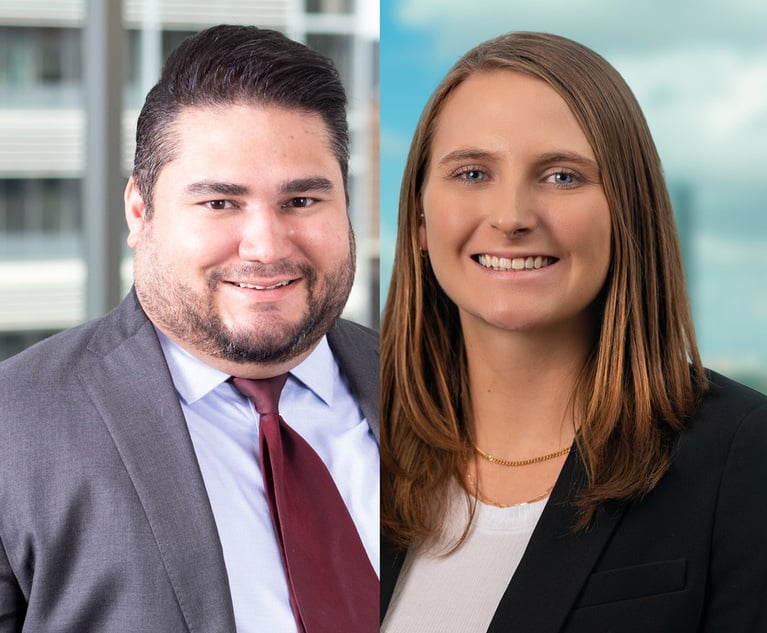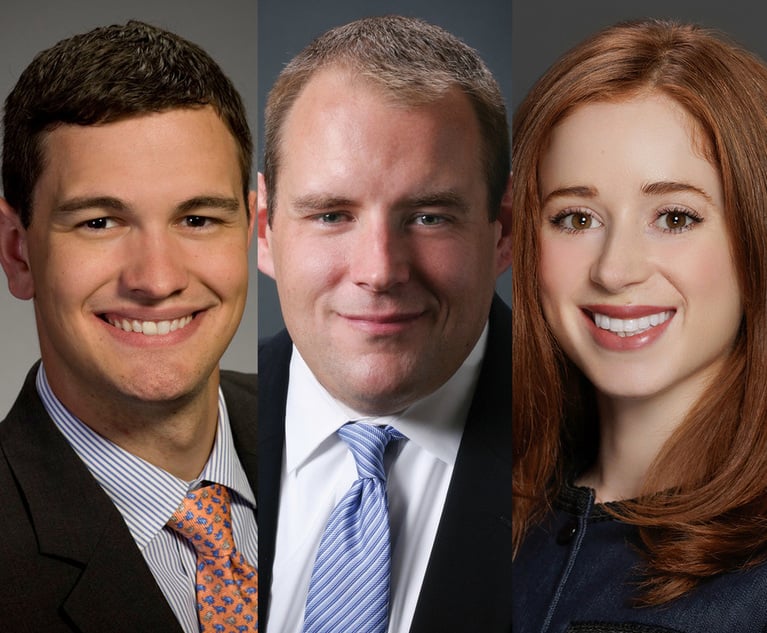Rethinking the Harassment Complaint Model
Allegations of sexual harassment and assault have hit the news almost daily over the last several weeks, with fingers pointing at Hollywood “A-Listers,” corporate executives, politicians, journalists, etc., etc., etc.
December 18, 2017 at 10:15 AM
5 minute read
 Andrew Rodman, of Stearns Weaver Miller Weissler Alhadeff & Sitterson in Miami.
Andrew Rodman, of Stearns Weaver Miller Weissler Alhadeff & Sitterson in Miami.
Allegations of sexual harassment and assault have hit the news almost daily over the last several weeks, with fingers pointing at Hollywood “A-Listers,” corporate executives, politicians, journalists, etc., etc., etc.
Many of the allegations have been raised years, or even decades, after the harassment allegedly occurred. Why have the victims, both men and women, waited so long to come forward? Many reportedly were afraid that coming forward would be career-ending. By remaining silent, those victims internalized the harm, and, in some cases, continued to endure further harassment by the same perpetrators. Their silence also may have enabled the perpetrators to harass other victims.
The Fear of Retaliation
In the “real world,” beyond Hollywood and Capitol Hill, how can companies eliminate the fear of retaliation that deters victims of harassment from coming forward immediately? Perhaps it's time to reexamine the complaint mechanism in the typical anti-harassment policy found in employee handbooks.
Most complaint mechanisms are multi-tiered, meaning that the complaining party is told to voice concerns to his/her immediate supervisor, human resources (particularly if the supervisor is the alleged perpetrator), or another management official. Many handbooks also include “open door” policies that invite employees to stop-by an executive's office at any time to talk about anything (and that anything could include allegations of harassment).
The primary goal of the typical complaint mechanism is to put the company on notice of the alleged harassment, give Human Resources a chance to investigate and (if necessary) take prompt remedial action, and create a working environment free of harassment for all employees.
Implementation of an anti-harassment policy with a complaint mechanism also may help employers establish an affirmative defense to liability in litigation (known as the “Faragher/Ellerth affirmative defense”) to some types of harassment claims, particularly if the employee did not follow the written complaint procedure.
Is Anonymous Reporting the Answer?
The typical anti-harassment policy may not remove the fear of retaliation, even if the policy expressly prohibits retaliation (as most do). Perhaps the fear of retaliation can be eliminated by incorporating into the complaint procedure an option for anonymous reporting. Of course, some employers' policies already provide for anonymous reporting, but it's far from universal.
Anonymous reporting is not a perfect solution. For one thing, without knowing the identity of the complaining party, it's much more difficult for human resources to investigate a complaint, particularly if the anonymous complaint lacks sufficient (or any) detail as to what happened, when it happened and who observed it happening. And, if HR can't complete a thorough investigation, which normally would include interviewing the complaining party, then HR may not be able to reach a reasoned conclusion, take remedial action (if necessary) against the perpetrator, and prevent future occurrences.
Anonymous reporting also may create proof problems when it comes to establishing the Faragher/Ellerth affirmative defense, which often turns on proving that the plaintiff failed to complain about the alleged harassment. If a complaint is anonymous, the employer may never know the source of the complaint.
Necessity Is the Mother of Invention
Despite the flaws inherent in anonymous reporting, some believe that an anonymous complaint is better than no complaint at all. That belief has given birth to a soon-to-be-launched website called AllVoices. Created by Claire Schmidt, a former technology executive at 20th Century Fox, AllVoices will provide an avenue for employees to bypass human resources and anonymously report harassment and discrimination directly to corporate CEOs and boards of directors.
AllVoices will aggregate reports of harassment and discrimination by company, deliver the complaints to each company without any personally identifiable information, and advise the complaining party when the target company has received the report and whether the company has taken action. Schmidt describes AllVoices as “a safe place for people to report what they've experienced without having to come forward publicly, risk their jobs or reputations, or fear retaliation.”
Only time will tell whether AllVoices succeeds in achieving its goals, but, in the interim, it would be prudent for all employers to review their anti-harassment and anti-discrimination policies to ensure that employees are, to the extent possible, undeterred in bringing complaints forward immediately.
Andrew Rodman is a shareholder in the labor & employment department at Stearns Weaver Miller and a member of the firm's board of directors. For more than 20 years, Rodman has represented employers in all aspects of the employment relationship, including both counseling and litigation. He is a frequent lecturer on labor and employment law issues and a contributor to the firm's blog, BelaborThePoint.com.
This content has been archived. It is available through our partners, LexisNexis® and Bloomberg Law.
To view this content, please continue to their sites.
Not a Lexis Subscriber?
Subscribe Now
Not a Bloomberg Law Subscriber?
Subscribe Now
NOT FOR REPRINT
© 2025 ALM Global, LLC, All Rights Reserved. Request academic re-use from www.copyright.com. All other uses, submit a request to [email protected]. For more information visit Asset & Logo Licensing.
You Might Like
View All

Leveraging the Power of Local Chambers of Commerce: A Second-Career Lawyer’s Guide to Building a Thriving Practice
5 minute read
CFPB Proposes Rule to Regulate Data Brokers Selling Sensitive Information
5 minute read
Essential Labor Shifts: Navigating Noncompetes, Workplace Politics and the AI Revolution
Trending Stories
- 1Relaxing Penalties on Discovery Noncompliance Allows Criminal Cases to Get Decided on Merit
- 2Reviewing Judge Merchan's Unconditional Discharge
- 3With New Civil Jury Selection Rule, Litigants Should Carefully Weigh Waiver Risks
- 4Young Lawyers Become Old(er) Lawyers
- 5Caught In the In Between: A Legal Roadmap for the Sandwich Generation
Who Got The Work
J. Brugh Lower of Gibbons has entered an appearance for industrial equipment supplier Devco Corporation in a pending trademark infringement lawsuit. The suit, accusing the defendant of selling knock-off Graco products, was filed Dec. 18 in New Jersey District Court by Rivkin Radler on behalf of Graco Inc. and Graco Minnesota. The case, assigned to U.S. District Judge Zahid N. Quraishi, is 3:24-cv-11294, Graco Inc. et al v. Devco Corporation.
Who Got The Work
Rebecca Maller-Stein and Kent A. Yalowitz of Arnold & Porter Kaye Scholer have entered their appearances for Hanaco Venture Capital and its executives, Lior Prosor and David Frankel, in a pending securities lawsuit. The action, filed on Dec. 24 in New York Southern District Court by Zell, Aron & Co. on behalf of Goldeneye Advisors, accuses the defendants of negligently and fraudulently managing the plaintiff's $1 million investment. The case, assigned to U.S. District Judge Vernon S. Broderick, is 1:24-cv-09918, Goldeneye Advisors, LLC v. Hanaco Venture Capital, Ltd. et al.
Who Got The Work
Attorneys from A&O Shearman has stepped in as defense counsel for Toronto-Dominion Bank and other defendants in a pending securities class action. The suit, filed Dec. 11 in New York Southern District Court by Bleichmar Fonti & Auld, accuses the defendants of concealing the bank's 'pervasive' deficiencies in regards to its compliance with the Bank Secrecy Act and the quality of its anti-money laundering controls. The case, assigned to U.S. District Judge Arun Subramanian, is 1:24-cv-09445, Gonzalez v. The Toronto-Dominion Bank et al.
Who Got The Work
Crown Castle International, a Pennsylvania company providing shared communications infrastructure, has turned to Luke D. Wolf of Gordon Rees Scully Mansukhani to fend off a pending breach-of-contract lawsuit. The court action, filed Nov. 25 in Michigan Eastern District Court by Hooper Hathaway PC on behalf of The Town Residences LLC, accuses Crown Castle of failing to transfer approximately $30,000 in utility payments from T-Mobile in breach of a roof-top lease and assignment agreement. The case, assigned to U.S. District Judge Susan K. Declercq, is 2:24-cv-13131, The Town Residences LLC v. T-Mobile US, Inc. et al.
Who Got The Work
Wilfred P. Coronato and Daniel M. Schwartz of McCarter & English have stepped in as defense counsel to Electrolux Home Products Inc. in a pending product liability lawsuit. The court action, filed Nov. 26 in New York Eastern District Court by Poulos Lopiccolo PC and Nagel Rice LLP on behalf of David Stern, alleges that the defendant's refrigerators’ drawers and shelving repeatedly break and fall apart within months after purchase. The case, assigned to U.S. District Judge Joan M. Azrack, is 2:24-cv-08204, Stern v. Electrolux Home Products, Inc.
Featured Firms
Law Offices of Gary Martin Hays & Associates, P.C.
(470) 294-1674
Law Offices of Mark E. Salomone
(857) 444-6468
Smith & Hassler
(713) 739-1250






